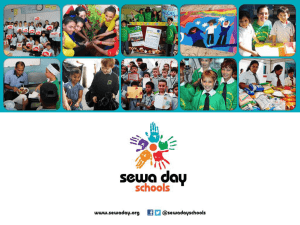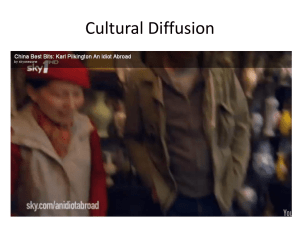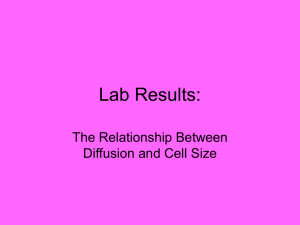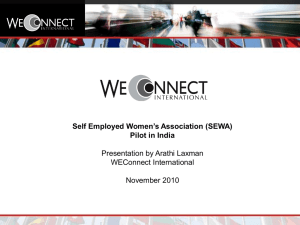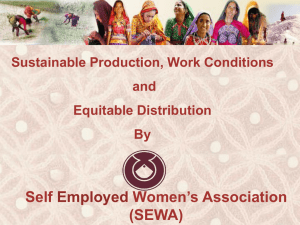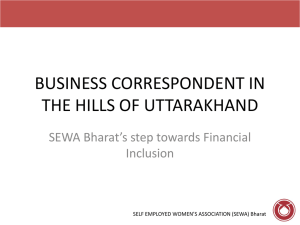Networks and the Diffusion of Pro-Social Innovations
advertisement
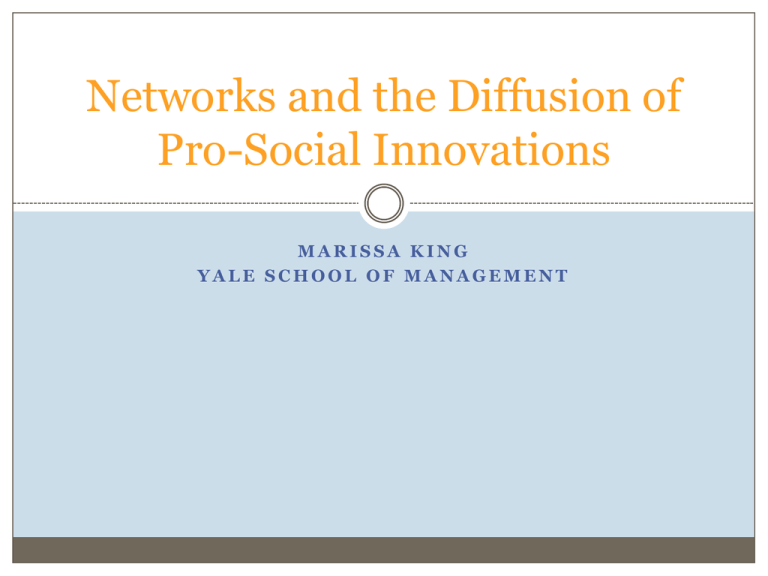
Networks and the Diffusion of Pro-Social Innovations MARISSA KING YALE SCHOOL OF MANAGEMENT Classic S-Shaped Diffusion Curve Percent Adopted Time Rogers. 1995. Diffusion of Innovations Home PC Air conditioner Refrigerator Cellular Phone Sources: PC, refrigerator, & cell phone: Lilien 1999; Air conditioner Sulltan 1990; Framework for Thinking About Endogenous Diffusion Structure Underlying network Product Simple Contagion Complex Contagion- Roger’s Five Factors Mechanisms Learning Possession Context Physical and Social Environment Same Framework Different Products and Contexts Antislavery organizations King, Marissa and Heather Haveman. 2008. “Antislavery in America: The Press, the Post, and the Pulpit, 17901840.” Administrative Science Quarterly 53:492-528 Cooperatives in the early 1900s Schneiberg, Marc, Marissa King and Thomas Smith. 2008. “Social Movements and Organizational Forms: Agrarian Protest and Cooperative Alternatives to Corporate Hierarchies in Three American Industries.” American Sociological Review 73:635-667. Autism King, Marissa and Peter Bearman. 2011. “Socioeconomic Status and the Increased Prevalence of Autism in California. American Sociological Review. 76:320-346. Liu, Kayuet, Marissa King, and Peter Bearman. 2010. “Social Influence and the Increased Prevalence of Autism Diagnosis.” American Journal of Sociology. 115: 1387-1434. Antidepressants, stimulants, & antipsychotics King, Marissa, Joseph Ross, Connor Essick, and Peter Bearman. Forthcoming.“Physician Conflicts of Interest and Psychotropic Prescribing.” BMJ King, Marissa and Peter Beaman. Conflict of Interest Policies and the Diffusion of Stimulant, Antidepressant, and Antipsychotic Medications. *Sanitation facilities, fuel efficient cook stoves, and solar lanterns in India * Roadmap Overview of framework Structure Product Mechanisms Context 2 Cases Potty Project-Sanitation facilities in Bhubansewar SEWA Hariyali Project-200,000 Fuel efficient cook stoves and solar lanterns Breakout Conclusion and experimental design Structure Social network analysis: • Both a theory and a method • Is motivated by a structural intuition based on ties linking actors • Social world as patterns or regularities among interacting units • Focuses on how patterns shape behaviors • Is grounded in systematic empirical data • Draws heavily on graphic imagery • Relies on the use of mathematical and/or computational models. StructureProductMechanismsContext Structure: Why do Networks Matter? StructureProductMechanismsContext Structure: Why do Networks Matter? StructureProductMechanismsContext Bearman, Moody, and Stovel 2001 Structure: Strong and Weak Ties Structural meaning (population level) • Strong ties produce triadic closure • Weak ties connect often connect distinct network clusters • Small worlds Relational meaning (dyadic) • Weak ties are acquaintances who you interact with less frequently • Weak ties connect otherwise socially distant actors • Betweeness centrality • Strong ties are close friends, family, etc. who you likely have an affective bond with and trust • Degree centrality Different types of ties have very different implications in diffusion processes StructureProductMechanismsContext Centrality example: Colorado Springs Node size proportional to betweenness centrality Graph is 27% centralized Rothenberg et al 1995 StructureProductMechanismsContext Centrality example: Add Health Node size proportional to betweenness centrality Graph is 45% centralized Bearman, Moody, and Stovel 2001 Random seeding vs. Influentials Influentials- Some individuals have a disproportionate number of ties Social networks tend to be scale-free and have long right tail Targeting influentials best way to encourage diffusion Random Seeding Identifying influentials is next to impossible so better off saving the money/resources you would allocate to them and randomly seed Single exposure/endorsement from one individual not as powerful as multiple exposures from several individuals Slide from Paul Adams “The Real Life Social Network” But Product Characteristics (What’s Diffusing) Also Matters…. SIMPLE CONTAGION • Standard epidemiological models • Examples include spread of easily transmittable information or disease that spread through simple contact • Mass marketing and broadcast diffusion • Weak ties COMPLEX CONTAGION • Behaviors are costly, risky, or controversial, the willingness to participate may require independent affirmation or reinforcement from multiple sources • Successful transmission depends on contact with multiple carriers/advocates • Social influence and peer effects Complex Contagion Requires Social Influence/Peer Effects StructureProductMechanismsContext Centola and Macy 2007 Product Characteristics: Roger’s Five Factors Factor Definition Relative Advantage How improved an innovation is over the previous generation. Compatibility The level of compatibility that an innovation has to be assimilated into an individual’s life. Complexity If the innovation is perceived as complicated or difficult to use, an individual is unlikely to adopt it. Trialability How easily an innovation may be experimented. If a user is able to test an innovation, the individual will be more likely to adopt it. Observability The extent that an innovation is visible to others. An innovation that is more visible will drive communication among the individual’s peers and personal networks and will in turn create more positive or negative reactions. StructureProductMechanismsContext Rogers 1995 Mechanisms Selection that produces correlated choices must be ruled out Social learning Learning by using Reduced uncertainty since peer’s consumption Possession Keeping up with the Jones Joint consumption StructureProductMechanismsContext Context If you introduce the same innovation on similar networks in different contexts do you see different patterns of diffusion? • King and Bearman (2011) and King and Bearman (2013) both found spatial differences in patterns of diffusion • • Socioeconomic status Regulatory environments But very few studies examine the diffusion of the same product in different markets Framework for Thinking About Diffusion Structure Underlying network Product Simple Contagion Complex Contagion- Roger’s Five Factors Mechanisms Learning Possession Context Physical and Social Environment Case Studies SEWA Cook Stoves & Lanterns Potty Project with Rodrigo Canales & Tony Sheldon PIs: Sharon Barnhardt, Judy Chevalier, & Mushfiq Mobarak. With Rodrigo Canales SEWA: Organization Overview 20 SEWA is a cooperative of low-income, self-employed women • Mission: organizing women workers for full employment and self-reliance • Registered as a trade union since 1972 • Membership of 1,356,000 women across 7 states in India Slide from Yale GSE SEWA Micro Team SEWA Hariyali Project Problems: Women and young children spend up to five hours a day in smoky kitchens Lung and eye health problems are common Women spend hours collecting fuel (wood) for the stoves,. Use of firewood contributes to deforestation. Goal: Sell 200,000 cook stoves over three years to clients in 4 states clients in 4 states (Gujarat, Rajasthan, UP and Bihar) Bundled with solar lantern Cook stoves reduce wood requirements and cooktime by ~50% Obstacles to Adoption • The targeted Hariyali demographic is highly price sensitive • Rs. 310 per month for 12 months • Significant behavior change required to switch from free to paid product • Health concerns are not sufficiently motivating factor Existing Network By virtue of SEWA membership already have shared common identity Members of each trade elect own representatives to Considerable geographic variation in size Rajasthan Bikaner Bihar 5,035 Dungarpur 3,300 Jaipur Ajmer UP Gujarat Bareli 402 60.8% Rural Lucknow 24,100 39.2% Urban 550 100 Jodhpur 183 9, 168 12,0000 24, 502 519,309 Current Sales & Reporting Method Salesperson visit village and does demonstration, members raise of hands to signal interest (V, M, O) Anand M V O Bodeli S % V M O Surendranagar S % V M O S % Mahesana V M O S % 12 425 47 4 11.05 10 237 9 0 3.79 3 128 1 0 0.78 7 140 10 0 7.14 15 455 53 22 11.64 8 228 0 0 0 7 169 9 5 5.32 8 182 11 0 6.04 13 293 54 24 18.4 11 353 3 0 0.84 9 197 3 3 1.52 6 141 7 0 4.96 20 440 22 13 5 6 154 2 0 1.29 5 149 5 2 3.35 4 71 17 0 23.94 12 250 25 14 10 18 561 1 0 0.17 4 91 2 2 2.19 7 127 8 3 6.29 13 250 13 11 5.2 9 248 0 0 0 0 0 0 0 0 10 173 17 0 9.82 14 260 20 11 7.69 3 64 0 0 0 0 0 0 0 0 13 204 23 22 11.27 17 440 43 36 9.77 18 515 1 0 0.19 0 0 0 0 0 20 415 16 16 3.85 Network Potential SEWA already has existing network and information about network members Relatively variability in village size Variability in connectedness between villages Product characteristics make cook stoves and lanterns good candidates for diffusion Visibility and trialability Potty Project Diffusion Analysis and Policy Evaluation with Rodrigo Canales Problem 45% of households use either public or communal toilets in the slums of Bhubaneswar and Cuttack 53% of these toilets are either “dirty” or “very dirty’ & one was completely non-functional Households dissatisfied with the cleanliness were the most likely to practice open defecation 30% of households reported doing so Barnhardt, Chevalier & Mobarak Potty Project Gates Foundation commissioned Quicksand Design Studio to conduct in-depth research into the behaviors, attitudes, and beliefs surrounding sanitation in lowincome urban India in 10 slums in 5 cities in India. Photos: Quicksand reprinted in Wall Street Journal Potty Project Based on their research they designed new sanitation facility prototype Design: Quicksand reprinted in Wall Street Journal Potty Project Barnhardt, Chevalier & Mobarak are utilizing Quicksand’s insights in a field experiment Paid Manager Cooperative Management Improved Facilities Basic New Facilities Basic Improved Facilities Enhanced New Facilities Enhanced • Basic facilities include adequate gender-separate toilets and washbasins, sufficient lighting and ventilation & enough water for all services • Improved facilities will include bathing, child toilets, menstruation waste • Experiment will also include discount coupons and varying pricing structure (monthly passes vs. pay-per-use) Why Networks Matter Quicksand pottyproject.in Network Context Lots of social cleavages Existing networks critical for both initiating use and creating community ownership to encourage sustainability Old facilities have existing network of users, new facilities do not Network data from household survey Study Design SEWA Context: How much does the importance of social influence vary by area and population ? Product: Give loaner cook stoves to seed network Structure and Mechanisms(?) Sales Pitch from Alter No Sales Pitch from Alter Random Seed Influentials No Network Seeding Sales pitch from outsider Potty Project Context: How much does the importance of social influence vary by area, toilet design, and composition of population ? Product: Use vouchers for facility (much like drug companies) Structure and Mechanisms(?) Sales Pitch from Alter Random Seed Influentials No Network Seeding Sales pitch from outsider No Sales Pitch from Alter Hariyali & Potty Project Additional research opportunities: Product abandonment How do networks change after introduction of new technology? Both projects will include extensive fieldwork and project evaluations Thanks!

